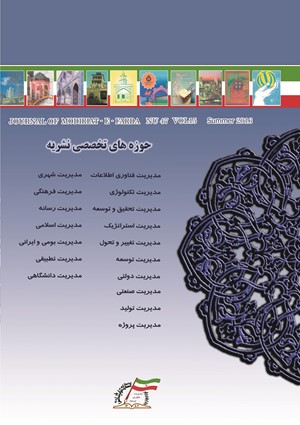نقش ويژگي¬هاي صنعتي درانتخاب شيوه¬هاي ¬مديريت منابع انساني و تقویت سرمايه اجتماعي سازمانی درکشور ایران
الموضوعات :سید محسن اقبالی 1 , علیرضا علی احمدی 2
1 - دانشگاه علم و صنعت
2 - دانشگاه علم و صنعت ایران
الکلمات المفتاحية: مديريت منابع انساني سرمايه اجتماعي سازماني مشخصه¬, هاي صنعتي ,
ملخص المقالة :
بسياري از دانشمندان علم منابع انساني و مديريت توليد، دهه ي آينده را دهه منابع انساني ناميده اند. در اين پژوهش بدنبال ارتباط شيوه هاي مديريت منابع انساني در راستای تقویت سرمايه ي اجتماعي سازمان و نقش تعديل کننده ي مشخصه هاي صنعتي بر روي آنها مي باشيم. بر اساس مطالعه اي که روي 30 شرکت برتردر صنايع مختلف در کشور ايران انجام گرفت، نتايج نشان داد که شيوه هاي مديريتي که روي تسهيل ارتباط ميان کارکنان تمرکز مي کنند، دررابطه با سرمايه ي اجتماعي سازمان بسيار مثبت تر و کاراتر مي باشند. همچنين سبب ارتباط قويتري براي شرکت هاي فعال در صنايع با پيچيدگي پايين تر مي شوند. نتايج نشان دادکه شدت دانش به خودي خود هيچ تاثير تعديل کننده اي ندارد و فقط به نظر مي رسد، وجود آن جهت پيوستن به مقررات صنعتي و نفوذ و اتصال آن با شيوه هاي مديريت منابع انساني و سرمايه ي اجتماعي سازماني لازم است. يافته هاي حاصل از تجزيه و تحليل هاي آماري نشان مي دهد که شيوه هاي مديريت منابع انساني اثر مثبت و با شدت بالايي بر روي سرمايه اجتماعي سازماني در صنايعي با حيطه ي کنترل پايين تر دارد. روش تحقيق در اين پژوهش از نوع تحقيقات توصیفی-پیمایشی بوده و جمع آوري اطلاعات به صورت هاي کتابخانه اي- اسنادي و پرسشنامه اي- ميداني صورت گرفته است. بمنظور تجزيه و تحليل داده ها نيز از نرم افزار SPSS استفاده شده است.
[1]-Maurer, I., Bartsch, V., & Ebers, M. (2011). The value of intra-organizational social capital:How it fosters knowledge transfer, innovation performance, and growth. Organization Studies, 32(2), 157–185.
[2]- Gittell, J. H., Seidner, R., & Wimbush, J. (2010). A relational model of how highperformance work systems work. Organization Science, 21(2), 490–506.
[3]- Haas, M. R., & Hansen, M. T. (2005). When using knowledge can hurt performance: The value of organizational capabilities in a management consulting company. Strategic Management Journal, 26(1), 1–24.
[4]- Gerhart, B., Wright, P.M., McMahan, G. C., & Snell, S. A. (2000). Measurement error in research on human resources and firm performance: How much error is there and how does it influence effect size estimates? Personnel Psychology, 53(4), 803
[5]- Bolino, M. C., Turnley, W. H., & Blooddgood, J. M. (2002). Citizenship behavior and the creation of social capital in organizations. Academy of Management Review, 27(4), 505–522.
[6]- Carmona-Lavado, A., Cuevas-Rodríguez, G., & Cabello-Medina, C. (2010). Social and organizational capital: Building the context for innovation. Industrial Marketing Management, 39(4), 681–690.
[7]- Chuang, C. H., & Liao, H. (2010). Strategic human resource management in service context: Taking care of business by taking care of employees and customers. Personnel Psychology, 63(1), 153–196.
[8]- Coff, R. (2011). Bidding wars over R&D-intensive firms: Knowledge, opportunism, and the market for corporate control. Academy of Management Journal, 46(1), 74–85.
[9]- Collins, C. J., & Smith, K. G. (2011). Knowledge exchange and combination: The role of human resource practices in the performance of high-technology firms. Academy of Management Journal, 49(3), 544–560.
[10]- Dawson, J. F., & Richter, A. W. (2010). Probing three-way interactions in moderated multiple regression: Development and application of a slope difference test.
[11]- Ellinger, A. E., Elmadağ Baş, A. B., Ellinger, A. D., Wang, Y., & Bachrach, D. G. (2011). Measurement of organizational investments in social capital: The service employee perspective. Journal of Business Research, 64(6), 572–578.
[12]- Payne, G. T., Moore, C. B., Griffis, S. E., & Autry, C. W. (2011). Multilevel challenges and opportunities in social capital research. Journal of Management, 37(2), 491–520.
[13]- Pérez-Luño, A., Cabello Medina, C., & Carmona Lavado, A. (2011). How social capital and knowledge affect innovation. Journal of Business Research, 64(2), 1369–1376
14- میرسپاسی، ناصر. مدیریت منابع انسانی. 1389. تهران. انتشارات دانشگاه آزاد


